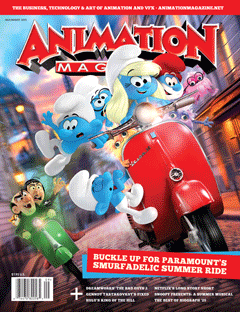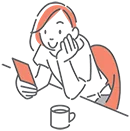|
Getting your Trinity Audio player ready...
|

This article was written for the
July-August ’25 issue of Animation Magazine (No. 351). |
The singing little blue folks are ready for their close-ups — again! Thanks to Paramount Animation’s summer feature Smurfs, a new generation of audiences will learn to love Belgian comic-book artist Peyo’s (Pierre Culliford) charming characters, which were first introduced in October 1958. The magical creatures, who live in a mushroom village and are only three apples tall, are part of a big musical feature, which showcases the voices of Rihanna (as Smurfette), John Goodman, JP Karliak, Nick Offerman, Sandra Oh, Hannah Waddingham, James Corden, Xolo Marideuña, Octavia Spencer, Dan Levy, Kurt Russell and Marshmello.
Best known to American audiences for the classic Hanna-Barbera series that ran from 1981 to 1989, three features produced by Sony and Nickelodeon’s CG series (2021-present), the Smurfs find themselves embarking on a daring mission into the real world after Papa Smurf (Goodman) is captured by Gargamel and his brother Razamel (both voiced by Karliak).
![Smurfs [Paramount Pictures]](https://www.beta.animationmagazine.net/wordpress/wp-content/uploads/Smurfs-FF-018.jpg)
Back to Peyo’s Village
The colorful and imaginative feature is directed by Chris Miller, best known for helming DreamWorks’ popular Shrek the Third (2007) and its Oscar-nominated spinoff feature, Puss in Boots, in 2011. The animation veteran says he was drawn to the project from the start for several reasons: “I loved the script, and I am a huge fan of the original Hanna-Barbera series,” he says during a recent interview with Animation Magazine.
“Another reason was that Paramount had the idea to go back to the characters’ original design and return to the DNA of the comics. My experience with the Smurfs was through the show from the ’80s, and so I discovered Peyo’s comics. I just loved the incredible designs, the movement on the page. The Sony movies that were [made] about 10 years ago were going for a more realistic feel. So, in the back of my mind, I wanted to see a contemporary version of those classic designs that was volumetric but still honored the original comic-book look.”
“In a way, our movie is really about the power of the community, which is what gives the Smurfs their superpower!”
— Director Chris Miller
Miller says the movie takes advantage of the visual contrast between the safe and magical Belgian forest where the Smurfs live and the live-action outside world where they must go to save Papa Smurf. “It’s like they’ve gone to another planet,” says the director. “There’s a sweetness to their original world that turns into chaos, and the big trick was to make sure that they could all visually exist in that live-action space, and I think we accomplished that.”
The creative team opted to use different kinds of animation to further expand the world of the little villagers. “We dabbled in various styles,” says Miller. “There’s some dimensional sequences, and we’ll see them as claymated characters and using children’s drawing style. That was fun, strange and weirdly nostalgic, which for us was important to leave a trace of the original work in everything that we were doing or at least tap into a memory that the audience may have, whether they’re 30 or 50!”
The lion’s share of the animation was produced by the teams at Cinesite in Vancouver and Montreal. “They also did the visual effects for the live-action sequences, and it was a very nice partnership,” says Miller. “We all had to zero in on the right style for the CG animation, but we always referred to Peyo as the ‘blueprint.’ The comics tell you how they move, and the energy, the buoyancy and ‘poppiness,’ everything is there. The trick was to be constantly aware of the simplicity of the design and make sure we were communicating real emotions with those Smurf eyes and mouths.”
![Smurfs [Paramount Pictures]](https://www.beta.animationmagazine.net/wordpress/wp-content/uploads/Smurfs-00471R.jpg)
The movie also features a two-minute claymated sequence that was delivered by L.A. indie shop Screen Novelties — known for crafting charming sequences for shows such as SpongeBob SquarePants and The Patrick Star Show. “I love that place,” says Miller. “They used stop-motion Gumby-style backgrounds, the characters were about eight inches high. It was just great to walk into this great studio, and it ended up being a really funny, fast-paced sequence, about a minute or two minutes long, but that’s where we’ll encounter every style.”
The film’s three-time Annie-nominated production designer, Max Boas, whose credits include Rise of the Guardians, Kung Fu Panda 3 and Abominable, mentions that one of the toughest aspects of the movie was that it was a “traveling film.” “We needed to get very organized for all the different locations, and because of the live-action element of these places, we needed to have a consistency in the way our animated characters looked in all of them,” says Boas. “And of course, we were inspired by the 2D sensibility, the linework, the graphic nature, his layouts and plant designs, all of them influenced our movie heavily. So, we had to figure out how to hold on to those elements but add the cinematic, volumetric lighting on top of the 2D sensibility. How do we maintain that with our characters so that the character lighting can still feel like the Smurfs have been pulled out of the 2D world?”
Boas says the Smurfs look amazing in three-quarter views that break the silhouette in the original comics. “The mouth was on the side in those views,” he notes. “Translating that into 3D animation is tricky, so you need to cheat the visuals a bit. We worked with Cinesite to develop the right look for the specific mouth shapes. The same is true with the hats, as their tops flop on the side, so stylistically, all of those had to be figured out for this movie. There was also the kind of 2D, hand-drawn effects that are mixed with 3D procedural effects. Those were a lot of fun to play with.”
In addition to Peyo’s work, Boas and his team were inspired by arcade culture and graphics found on video game boxes in the 1980s. “Because the Smurfs travel through these portals, through these different worlds, we knew it was going to feel like traveling through outer space,” he says. “So we figured, what if our skies and backgrounds felt like a hand-painted, airbrushed graphics you would find in that era? We were really going for those kind of really bright colors and playfulness.”
“The goal was to figure out how to hold on to those 2D comic-book elements but add the cinematic, volumetric lighting on top of the 2D sensibility.”
— Production Designer Max Boas
For Boas, one of the big musical numbers featuring Rihanna as Smurfette was a major highlight. “There’s a standout scene where she is in the outback, and there’s a great transition from live-action into the 2D/CG world,” he recalls. “Smurfette dives from a tee into the water, and then it feels like outer space. It’s kind of a magical moment when she’s singing one of her new songs. Of course, because it’s a song-and-dance number, it requires a lot of planning, but I grew up watching music videos. So, I enjoyed the elements of storytelling that unfold with the music. You need a little bit more color scripting to figure out how you are going to handle those key moments, but I find the process really fun.”
Shades of Muppets
The movie introduces audiences to a wide range of strange and memorable new characters, including Papa Smurf’s brother Ken (voiced by Nick Offerman). There’s also a whole group of interdimensional creatures called the Snooterpoots, led by their matriarch, Mama Poot (voiced by Natasha Lyonne). As Miller recalls, “When we were coming up with Mama Poot, I used my own dog, who is a Shih Tzu, as reference. The Poots ended up looking somewhere between a Wookie and an Ewok baby. They are very similar to the Muppets … they even move like them a bit.”
The director says he truly values the underlying message behind this latest incarnation of the characters. “One of the main driving stories in the movie belongs to a character called No Name (voiced by James Corden), who is the only one in the Smurf Village without an identity or a built-in skill set, so he’s on a bit of an obsessive, angst-ridden journey,” he explains. “Fast-forward to the end of our movie, and he has taken this dangerous journey to rescue Papa Smurf. They come across these family secrets that actually reveal all the Smurfs’ place in the universe. So, it’s sort of an origin story about how they ended up in the forest. In a way, our movie is really about the power of the community, which is what gives the Smurfs their superpower!”
Paramount’s Smurfs opens in theaters nationwide on Friday, July 18.


![Smurfs-FF-055 Smurfs [Paramount Pictures]](https://www.beta.animationmagazine.net/wordpress/wp-content/uploads/Smurfs-FF-055-696x292.jpg)
![Smurfs [Paramount Pictures]](https://www.beta.animationmagazine.net/wordpress/wp-content/uploads/Smurfs-FF-065K.jpg)
![Smurfs [Paramount Pictures]](https://www.beta.animationmagazine.net/wordpress/wp-content/uploads/SMURFS_TRAILER_NEW_PARAMOUNT_JULY-18_.jpg)
![Smurfs [Paramount Pictures]](https://www.beta.animationmagazine.net/wordpress/wp-content/uploads/Smurfs-FF-048.jpg)
![Chris Miller - Smurfs [Paramount Pictures]](https://www.beta.animationmagazine.net/wordpress/wp-content/uploads/Smurfs-Chris-Miller-240x240.jpg)
![Smurfs [Paramount Pictures]](https://www.beta.animationmagazine.net/wordpress/wp-content/uploads/Smurfs-FF-066.jpg)
![Smurfs [Paramount Pictures]](https://www.beta.animationmagazine.net/wordpress/wp-content/uploads/Smurfs-FF-047.jpg)
 “The goal was to figure out how to hold on to those 2D comic-book elements but add the cinematic, volumetric lighting on top of the 2D sensibility.”
“The goal was to figure out how to hold on to those 2D comic-book elements but add the cinematic, volumetric lighting on top of the 2D sensibility.”![Smurfs [Paramount Pictures]](https://www.beta.animationmagazine.net/wordpress/wp-content/uploads/Smurfs-FF-064K.jpg)

 Win 'Grave of the Fireflies' LE SteelBook!
Win 'Grave of the Fireflies' LE SteelBook! 
